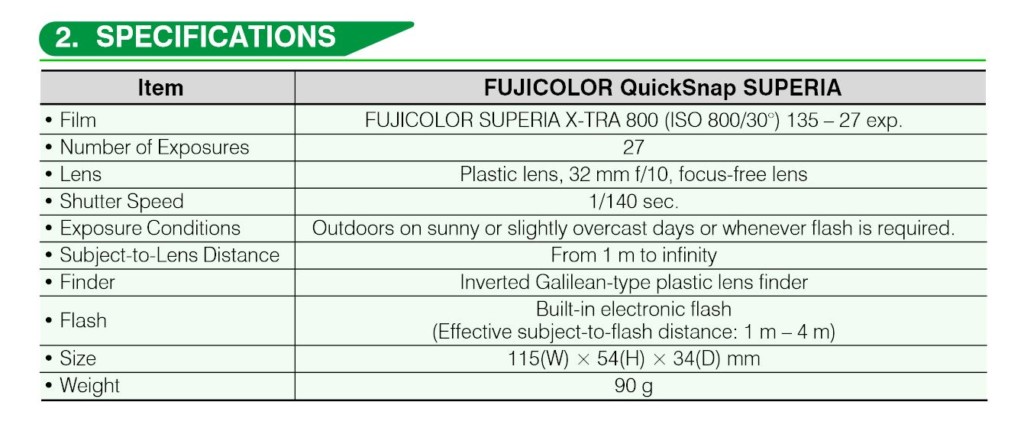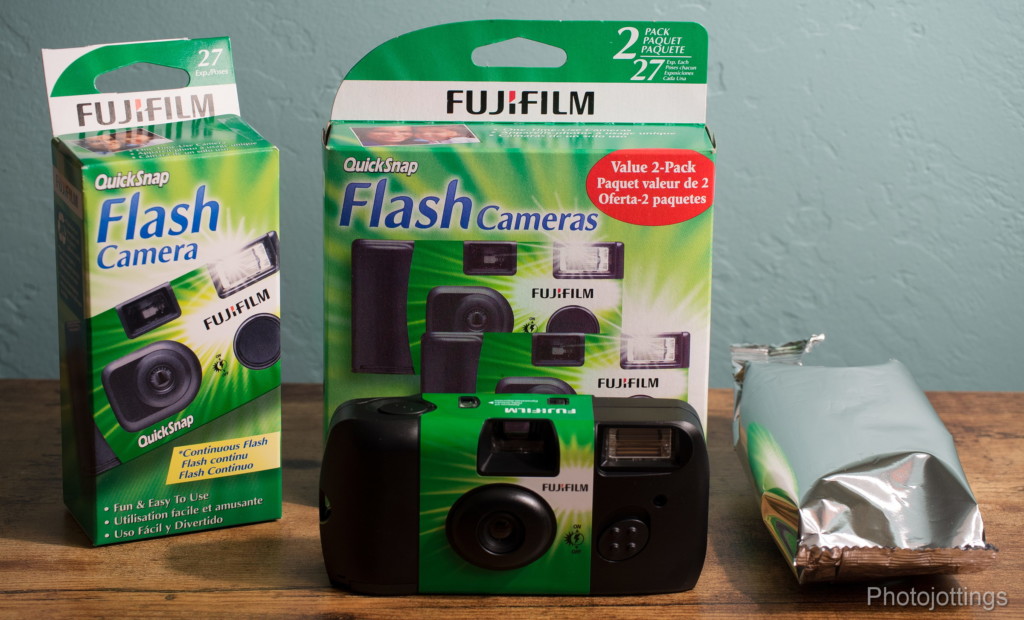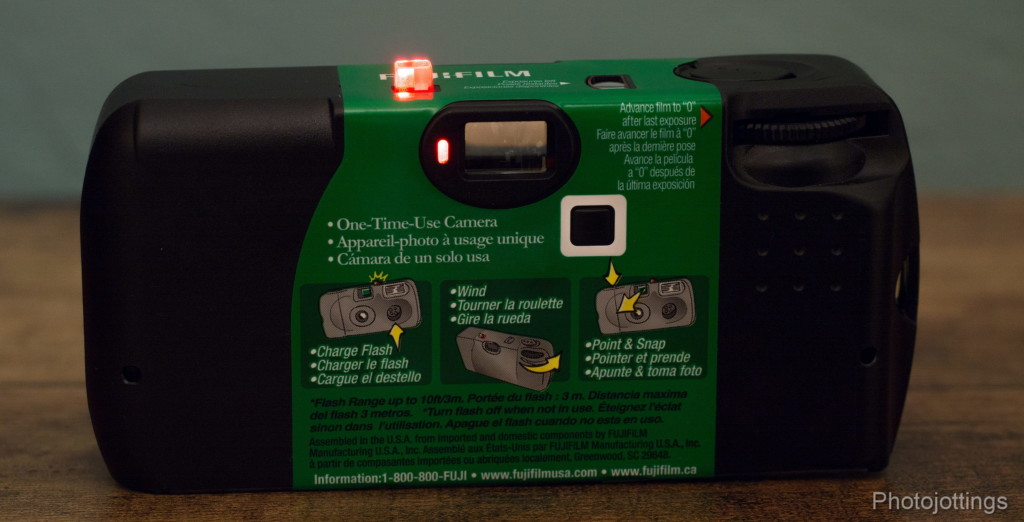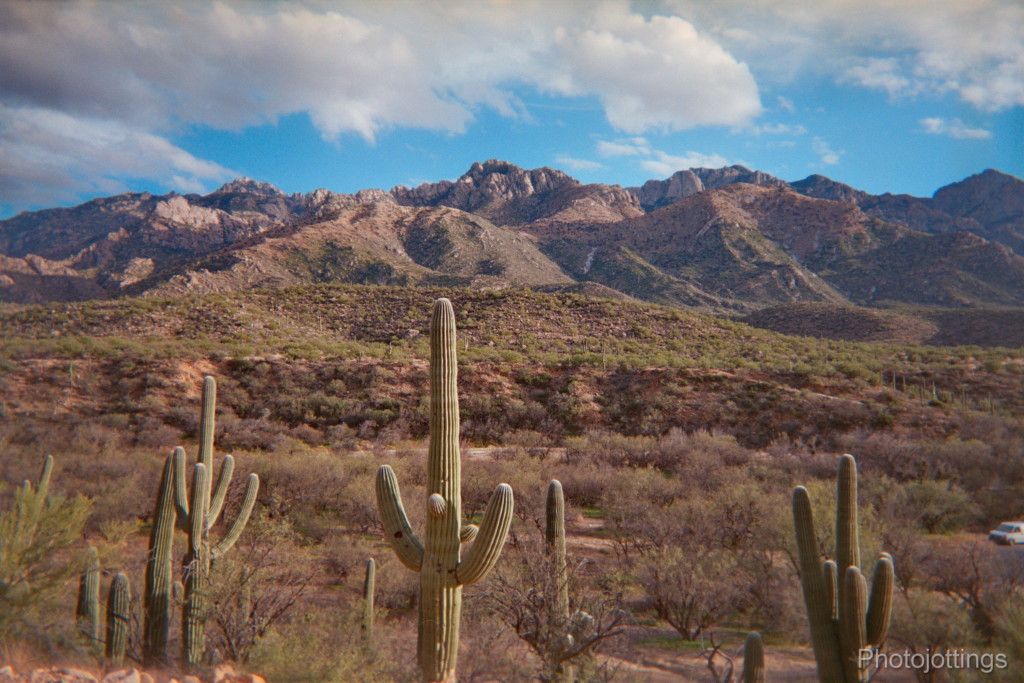
The FujiFilm QuickSnap Flash, B&H, Amazon, eBay, is a ‘single use,’ ‘throw-away’ or ‘disposable’ camera, whichever term you prefer. Like nearly all single use cameras, it has a very simple plastic lens, manual film advance, and 27 exposures. This model comes with a flash.
These little cameras are about as easy to use as it gets for film. The film is already loaded, all you do is advance the film via thumb wheel until it won’t turn anymore, then simple look through the viewfinder and take a snap. If you want a little fill flash, just push the button up on the front of the camera until the pop-up plastic piece turns red, which means the flash is ready, see pic below.
You’ll see a bunch of these at weddings where the guests are encouraged to pick them up and start shooting, especially after the liquor starts to flow, then turn them in to the hosts before going home so the newlywed couple can get them developed and have some laughs later on.
Number of exposures: Fuji uses their Superia 400 film which is marketing by itself as 24 exposures, but loading in a darkroom as they do when making the camera yields 27 images. You can get 27 images on any roll of 24 as long as you can load the camera yourself in the dark and do not have to advance it to the first shot mark; however, with motorized auto loading cameras, you probably won’t get any more than 25.
The flash is for fill only as the shutter speed is set at 1/140 second. However, it’s quite powerful considering the F/10 aperture, and much more so than your very best smartphone flash or LED.
Cost; between $4 and $9 for singles, and around $12-$15 for a twin pack. I paid $4 for a single camera on sale in 2017, normal price is about $7.
The Specifications below are for the 800 speed film camera which is not available anymore as far as I can tell, but the waterproof one is still current. I could not find the white sheet for the ISO 400 film camera, however, because I don’t think they’d have two different models for each type of film, I’d guess the specs are the same for the ISO 400 camera with the exception of the flash range, which is now 3 meters maximum instead of the listed 4 meters.

Below are some product shots.


If you want to keep the camera for some reason after you’ve finished the last shot, just pry the plastic door up with a knife or screwdriver, and the film canister will drop out. Be careful as the battery and flash apparatus is right beside the door, and will shock you if you touch it.

Here are some samples for you to enjoy. Click for larger images. All are 2400 pixels wide, and will not show any more detail even when scanned at a higher rate. I think about 1600 pixels wide is actually all the detail you’ll get with a good scan. I used the Nikon Coolscan 9000 ED for these.








The FujiFilm QuickSnap takes some decent photos if you enjoy looking at 4×6″ prints, or just want something different for a change. My Mom went back to using disposable cameras this year as she got tired of fooling around with a digital camera that was always dead when she wanted to use it, of it didn’t focus right, or recorded video when she just wanted a still image.
The QuickSnap has no such problems. The battery will stay charged for years; and even if it goes bad, you can still use the camera outdoors in good light. I used a disposable camera for a couple of years before It ran out of film, and stored it in my car in the summer where it’s 150° (65°C) degrees inside. When I got the pictures back from the shop, they turned out just fine.
As far as quality is concerned; I don’t think the FujiFilm QuickSnap is any better or worse than the Kodak HD power flash Funsaver, the only real difference is the flash button. Kodak uses ISO 800 film and seems to produce brighter pictures in lower light levels, especially with the flash on.
All things considered, the FujiFilm QuickSnap single use camera is fun, and puts out decent photo quality, especially if you scan the negatives yourself with a good dedicated film scanner. If you rely on your local developer/printer, you will probably not get anything close to what you see here, the reason being they scan the negatives too quickly, and that results in a poor light range from deep shadows to bright skies; plus, the colors are not really accurate/punchy in my opinion. But then again, this is a fun camera, right? and if the images look crappy, so what, you had fun just taking the pictures!
Check out the FujiFilm QuickSnap here; B&H, Amazon, eBay, and help support the site, thanks!